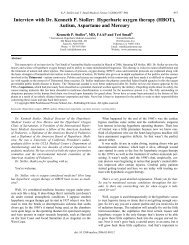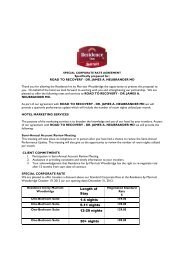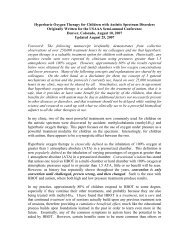Interview with Dr - Dr. Neubrander
Interview with Dr - Dr. Neubrander
Interview with Dr - Dr. Neubrander
Create successful ePaper yourself
Turn your PDF publications into a flip-book with our unique Google optimized e-Paper software.
948<br />
D.A. Rossignol and T. Small/Medical Veritas 3 (2006) 944–951<br />
dsDNA antibody titers, and immune-complex deposition in<br />
lupus-prone autoimmune mice. HBOT has also been shown to<br />
decrease markers of inflammation including IL-1, IL-6 and<br />
TNF-α in humans.<br />
Does HBOT help gut issues such as colitis and yeast<br />
HBOT has been used in animal studies to improve colitis.<br />
Interestingly, thirty sessions of HBOT at 2.0 ATA has been<br />
used in humans to achieve remission of ulcerative colitis not<br />
responding to conventional therapies. HBOT has also been used<br />
extensively and successfully in patients <strong>with</strong> Crohn’s disease<br />
not responding to medical therapy. I think there is more evidence<br />
that HBOT works for Crohn’s disease than for many<br />
other so-called “approved” conditions. This may be relevant in<br />
autistic children given the higher prevalence of gastrointestinal<br />
mucosal inflammation described above. HBOT may help <strong>with</strong><br />
yeast but this is something that needs further study to clarify.<br />
What is oxidative stress, and what evidence of this is there in<br />
autism<br />
Oxidative stress is mainly due to what are called free radicals.<br />
Free radicals are highly reactive, unstable molecules that<br />
have an unpaired electron in their outer shell. They react <strong>with</strong><br />
various cellular components including DNA, proteins, lipids<br />
and fatty acids and cause DNA damage, mitochondrial malfunction,<br />
cell membrane damage and eventually cell death. Free<br />
radicals are formed during a variety of biochemical reactions<br />
and cellular functions (such as mitochondria metabolism). The<br />
steady-state formation of free radicals (which are also called<br />
pro-oxidants) is normally balanced by a similar rate of consumption<br />
by antioxidants. Oxidative stress results from an imbalance<br />
between formation and neutralization of pro-oxidants.<br />
Various pathologic processes disrupt this balance by increasing<br />
the formation of free radicals in proportion to the available antioxidants<br />
(thus, oxidative stress). Examples of increased free<br />
radical formation are immune cell activation, inflammation,<br />
ischemia, infection, cancer and so on. Free radical formation<br />
and the effect of these toxic molecules on cell function (which<br />
can result in cell death) are collectively called “oxidative<br />
stress.”<br />
Antioxidants are molecules or compounds that act as free<br />
radical scavengers. Most antioxidants are electron donors and<br />
react <strong>with</strong> the free radicals to form innocuous end products such<br />
as water. These antioxidants bind and inactivate the free radicals.<br />
Thus, antioxidants protect against oxidative stress and prevent<br />
damage to cells. By definition, oxidative stress results<br />
when free radical formation is unbalanced in proportion to the<br />
protective antioxidants. There are many examples of antioxidants:<br />
Intracellular enzymes: superoxide dismutase (SOD), glutathione<br />
peroxidase<br />
Endogenous molecules or molecules normally found in the<br />
body: glutathione (GSH), sulfhydryl groups, alpha-lipoic<br />
acid, Coenzyme Q10<br />
Essential nutrients: vitamin C, vitamin E, selenium, N-acetyl<br />
cysteine (NAC)<br />
Dietary compounds: such as bioflavonoids<br />
All cells have intracellular antioxidants (such as superoxide<br />
dismutase and glutathione) which are very important in protecting<br />
all cells from oxidative stress at all times. Glutathione is<br />
very important as an intracellular antioxidant. GSH has been<br />
found to be low in many disease states indicating oxidative<br />
stress and inadequate antioxidant activity to “keep up” <strong>with</strong> the<br />
free radicals.<br />
Recent studies have shown that autistic children have evidence<br />
of increased oxidative stress including lower serum glutathione<br />
levels. One study demonstrated that autistic children<br />
had increased red blood cell nitric oxide, which is a known reactive<br />
free radical and is toxic to the brain. Jill James recently<br />
showed that total serum glutathione levels were 46% lower and<br />
oxidized (or the bad form of) glutathione was 72% higher in<br />
autistic children when compared to neurotypical controls. This<br />
led to decreased antioxidant ability in these autistic children.<br />
Lower serum antioxidant enzyme, antioxidant nutrient, and<br />
glutathione levels, as well as higher pro-oxidants have been<br />
found in multiple studies of autistic children. Furthermore,<br />
treatment <strong>with</strong> anti-oxidants has been shown to raise the levels<br />
of reduced glutathione in the serum of autistic children and appears<br />
to improve symptoms.<br />
Does HBOT have any effect on this<br />
Multiple studies have shown neutral effects on oxidative<br />
stress <strong>with</strong> HBOT use. In one study on horse platelets, measures<br />
of oxidative stress were not increased after HBOT; in fact, a<br />
rise in the antioxidant enzyme superoxide dismutase (SOD) was<br />
found 24 hours after HBOT <strong>with</strong>out a fall in glutathione levels.<br />
In another study on dogs, following 18 minutes of complete<br />
cerebral ischemia, HBOT at 2.0 ATA reduced brain damage<br />
<strong>with</strong>out increasing oxidative stress. Furthermore, in a rat model<br />
of reperfusion, HBOT extended skin flap life <strong>with</strong>out evidence<br />
of oxidative stress.<br />
In addition, numerous studies have shown improvements in<br />
oxidative stress <strong>with</strong> HBOT including increased production of<br />
antioxidants and antioxidant enzymes and decreased markers of<br />
oxidative stress such as malondialdehyde. An improvement in<br />
the survival rate of skin flaps and an increase in SOD levels<br />
were found in one study when rats were exposed to hyperbaric<br />
oxygen at 2.0 ATA. In another study, HBOT at 2.5 ATA induced<br />
the production of antioxidants and decreased malondialdehyde<br />
levels in rats. Furthermore, in a study of rats <strong>with</strong> pancreatitis,<br />
HBOT at 2.5 ATA decreased oxidative stress markers<br />
including malondialdehyde, and increased the levels of the antioxidant<br />
enzymes glutathione peroxidase and SOD. HBOT has<br />
also been shown to acutely raise the levels of reduced glutathione<br />
in the plasma and lymphocytes of some humans after<br />
just one treatment session at 2.5 ATA. Finally, ischemiareperfusion<br />
injuries usually cause oxidative stress through decreases<br />
in glutathione levels and activities of catalase and SOD.<br />
However, in one rat study of ischemia, pretreatment <strong>with</strong> 1-3<br />
doses of HBOT caused an increase in liver glutathione and<br />
SOD levels and protected against liver injury; control animals<br />
not receiving HBOT actually had drops in glutathione and antioxidant<br />
enzyme levels and had liver damage associated <strong>with</strong><br />
this.<br />
doi: 10.1588/medver.2006.03.00110





